| RC4 'EVOLUTION' SHOTGUN SLUGS: THE ACID TEST |
| by |
| 'Marrakai' |
During a recent feral pig culling operation in Northern Australia, the opportunity to test the new RC4 shotgun slugs on wild boar under field conditions produced some rather un-expected and surprising results.
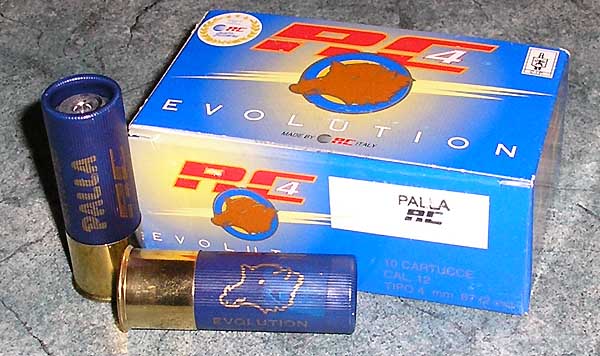 |
| Distinctive blue box of RC4 'Evolution' 12-bore slug cartridges |
I had first noticed the imported Italian slug cartridge while shopping unsuccessfully for Brenneke solids perhaps a year before, and liked the look of them right at the outset. The 'Evolution' 12-bore slug was listed as 1 1/8 oz on the RC web-site, which I thought might give it an edge over the standard Winchester 'Foster'-style 1 oz projectile. Boxes were marked with the word palla, which I later learned was Italian for 'ball' ammunition, and featured a ferocious-looking boar's head in gold as the centrepiece of the eye-catching label. There on the shop-counter, they certainly gave the impression of serious pig-medicine!
|
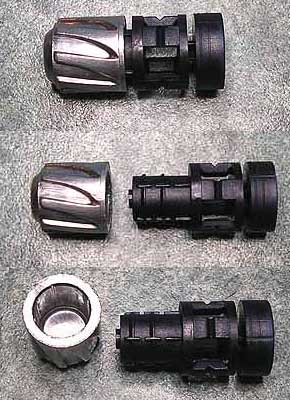 |
||
| RC4's Evolutionary Slug/Wad Design |
same manner as an extra 1/8-oz of lead! Nevertheless, an accurate-shooting 1-oz modernised Foster-style slug should still have considerable merit as a hog-hammer, so the next step was to determine just how accurate the RC4 'Evolution' could be.
Some time previously I had acquired a Birmingham box-lock side-by-side shotgun by William Griffiths at a very reasonable price, since the previous owner's 'best mate' had stuck the muzzles into a billabong to shoot a fish! The top and bottom ribs had peeled back like banana-skin, and the ruptured right barrel necessitated the removal of about 5 inches off the total length. The result was a nicely-engraved 25-inch barrelled SxS smooth-bore with no chokes whatsoever, and it was a simple matter to regulate the little double for the new RC4 solids and re-lay the ribs. A taller gold bead foresight was added during the process, and a tube-style 'ghost ring' rear sight was temporarily attached to the breech-end of the top rib for the duration of the trials.
Shortened and re-regulated William Griffiths boxlock with 'ghost ring' rear sight. |
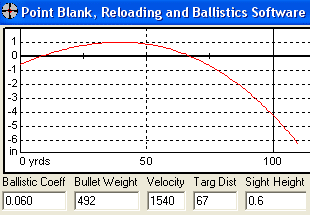 |
the little 6 1/2 lb game gun! Of course, shotgun solids are often used in specially designed slug barrels measuring only 24 inches or less, so I did not feel at all handicapped by the shortness of the de facto double-slugger. My confidence was vindicated when the palla loads actually produced 1565 fps over the chrono some 6 feet ahead of the muzzles! That equates to a Muzzle Energy of 2680 ftlbs if the wad is included as part of the projectile, and 2380 ftlbs for the lead slug alone: more than enough to flatten feral hogs given the large frontal area, and the anticipated expansion suggested by the hollow dimple in the nose. |
| Sighted dead-on at 67 yds, the mid-range trajectory is only one inch, and the drop at 100 yds a mere 4 inches. That's extremely flat-shooting for a smooth-bore slug! |
Shooting the 'Evolution' for accuracy in the re-regulated double further restored my confidence in the hybrid slug. Right and left barrel pairs of shots were often touching at 25 metres, with several of the pairs forming only one ragged hole! Composite 4-shot groups averaged 1 3/4 inches on centres, and were right on the point of aim! The average distance apart at 50 metres was a very
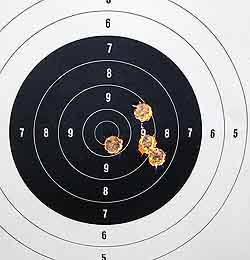 |
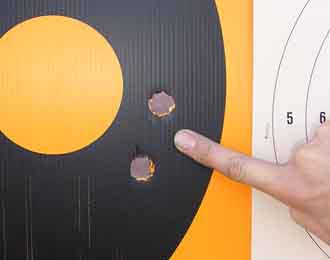 |
| Typical 25m 4-shot composite group | 50m 'right and left' pairs averaged 2 1/2 inches |
impressive 2 1/2 inches on centres, astounding accuracy considering the origins of this particular SxS double gun, and the relatively crude open sights. With any doubts about accuracy laid firmly to rest, it was time to introduce the palla to the pigs!
The day of departure for the culling operation soon arrived, and the Wm Griffiths 12-bore double was carefully packed along-side eight blue boxes of the RC4 'Evolution' cartridges. After several
| successful days with centre-fire rifles, it was my turn as 'camp dog' and I had just settled in to the camp chores, personal laundry, and a little rifle maintenance when a large boar casually wandered down to the water's edge opposite for a mid-morning wallow. Too far for the shotgun, he was duly despatched with a 140gr 6.5 bullet, and thinking that this couldn't possibly happen twice I wandered around to check the trophy quality armed with nothing more than a shovel (he would have to be buried this close to camp!), camera and knife. |
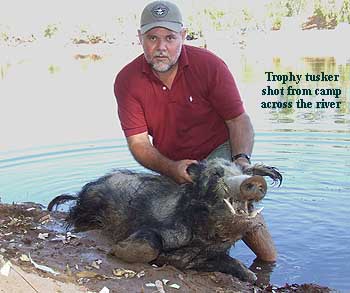 |
Well, you guessed it! I disturbed another solid boar wallowing in a secluded corner just 100 metres short of the previous victim, but could only watch as he slowly wandered up the embankment, stopping occasionally to give me the evil eye! After a final glowering stare in my direction, he disappeared over the top into the riverine thicket.
I thought about this for a second, and quickly came to the conclusion that the arrogant old fellow was relatively undisturbed, as the breeze had been in my favour, so he probably wouldn't have gone far. Jamming the shovel into the sand, I dropped the other items and retraced my steps back around the end of the waterhole towards camp to grab a firearm and seek conclusions with the belligerent boar. The perfect opportunity to test the RC4 'Evolution' slugs on a sizeable hog had finally arrived!
Twenty minutes later I poked my head up over the bank where the brazen grunter was last seen, and discovered a vine-choked gully parallelling the river some 50 metres back. Creeping forward with the Griffiths double at the ready, I began to scrutinize the shadier spots in which a boar might bed down for the afternoon. With an RC4 slug in the right chamber and an SG cartridge in the left, I hoped the spare palla in my pocket would not be needed. After covering no more than 70 metres I caught movement out of the corner of my eye, and looked back towards the river to see the big fellow stand up in his bed right at the crest of the embankment, rub his itchy backside on a log for a half-minute or so, then plonk back down on his belly. Gotcha!
Halving the distance amongst the vines and thorn was not easy, but I knew I would only have one chance and I couldn't afford a deflection. Eventually I had a clear view of the bedded animal at perhaps 20 yards, and taking a steady offhand shot I placed the RC4 solid right on the point of his shoulder. To my utter astonishment, the boar leapt to his feet and took off at top speed! As he cleared the tangle of debris in full stride I belted him with the load of SG from the second barrel, and down he went in fine fashion!
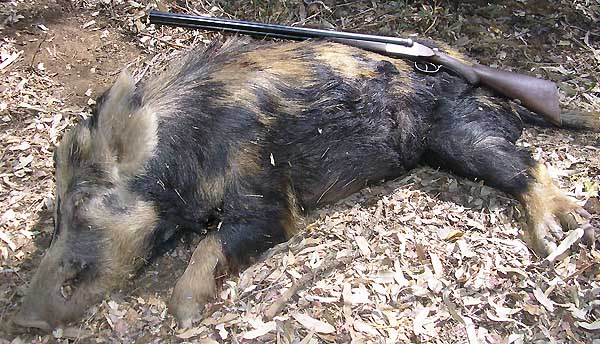 |
| First boar taken with the RC4 'Evolution' slug |
Well...! That was not what I expected at all! Had I missed with the first barrel? ...or was the shot poorly placed? Moving over to discover what had actually transpired, I realised the downed hog was still breathing, so I quickly reloaded the spare RC4 shell and moved into position to administer a finisher to the spine between the shoulder-blades. At the shot, absolutely nothing happened! The strained breathing continued uninterrupted, without even a flinch! At this point I decided to retrieve my knife to stick him if necessary, but when I returned a few minutes later he had thankfully expired.
 |
| Slug had smashed the shoulder-bone to splinters but failed to penetrate any further |
Rolling the prostrate pig over, I noted with satisfaction the perfectly-placed gaping round hole on the point of the shoulder, although why it had failed to anchor the boar in his sandy bed was not immediately clear. Slicing up beneath the arm-pit and lifting the fore-leg away, I was stunned by the completely clean chest wall: the slug had totally failed to penetrate the shoulder! Cutting in from the entrance hole revealed the mangled blue wad an inch or so beneath the skin, with a mess of bone slivers and lead fragments just below that. The projectile had struck the humerus dead center, splintering the bone and literally disintegrating in the process! Total penetration was less than 3 inches!
Oh well, it did centre-punch the heavy shoulder-bone, perhaps that was to be expected...?
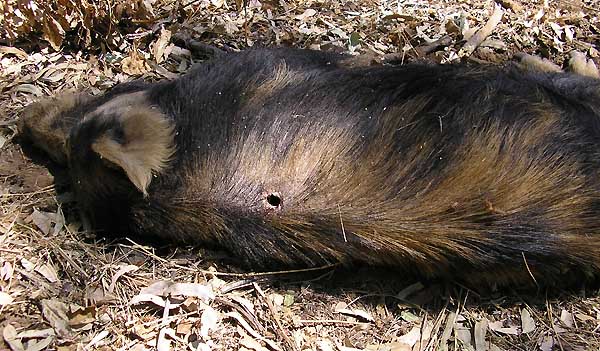 |
| 'Finisher' into the spine penetrated only 4 inches and failed to break any vertebrae! |
Turning my attention to the second entrance wound between the shoulder-blades, I located pieces of the wad lodged just below the bristly hide, and a similar collection of lead shards was discovered against the vertebral column after penetrating only 4 inches! Furthermore, the second slug had utterly failed to break the spine! In disbelief, I split the rib-cage and completely removed the lungs to confirm that not one single piece of 'shrapnel' had penetrated into the chest cavity!
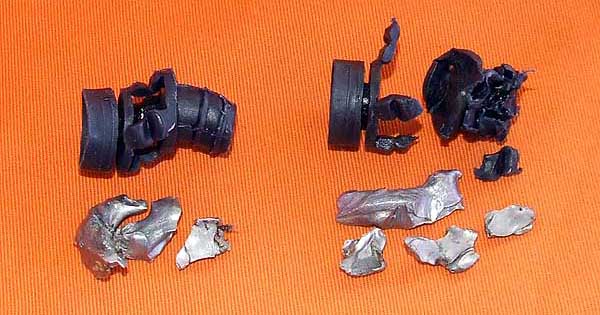 |
| First two RC4 slugs hit bone and shattered, limiting penetration to 3 or 4 inches |
Hmmm! Perhaps I was expecting too much from these 'evolutionary' slugs? After all, both had struck heavy bone. I would have to give them some further opportunities to prove themselves, and make an effort to avoid the larger bones which so far appeared to be their nemesis.
The next opportunity arrived a few days later during a morning walk along the river levee. I had jumped a group of hogs in a weed-choked overflow, several of which had succumbed to close-range SG delivery, when a second mob appeared only 50 metres away moving slowly off towards the river. Rushing to intercept their exodus, I managed to kill a large sow with the first barrel, then anchored a big boar with the second shot although he was not killed outright by the SGs and would need a finisher. I loaded an RC4 palla and this time took particular care to place the shot into the lower rib-cage behind the front leg and well below the tough 'fighting pad' on the shoulder. At last, the RC4 slug seemed to knock the fight right out of him, and he expired without fuss. This was more like it!
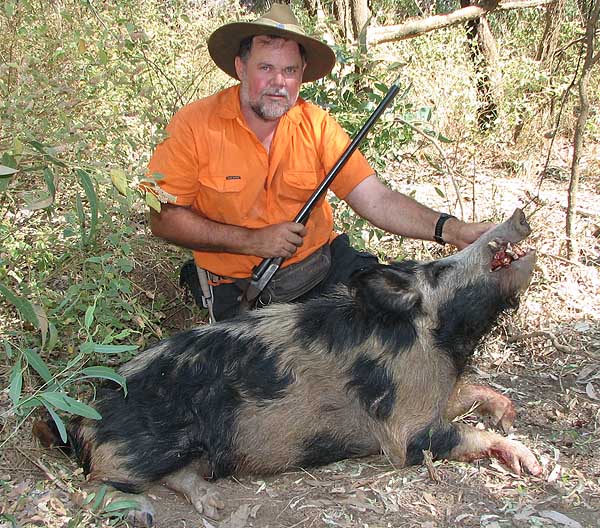 |
| Second boar finished-off with a well-placed RC4 slug |
A quick autopsy showed that the slug had performed better than the previous examples, although penetration was barely acceptable. Passing through the lower chest and lodging against the far ribs, the largest piece of the projectile consisting of the front wall of the slug had retained its shape, even though the 'skirt' had completely broken away and fragmented within the wound channel. The hollow 'dimple' in the slug's nose had been blown out as well. This created a 'donut' effect, but considerably lighter in weight and momentum than the familiar lead donut produced by a Foster-style slug when its skirt compresses into the nose.
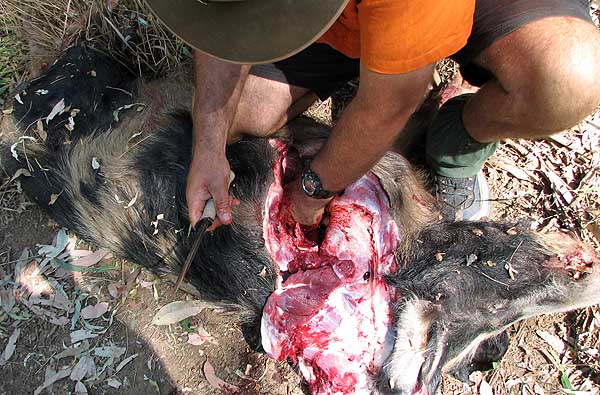
Recovering the projectile for terminal ballistics assessment

Nose of projectile penetrated the chest cavity although the skirt broke up badly
Although the RC4 palla had indeed killed the boar on this occasion, total penetration was only 9 inches. I was still far from convinced that these slugs could be taken safely against large boars with their propensity to become quite dangerous when wounded. Clearly, further evaluation was still required!
The next chance to test the RC4 slug arrived the following day, when my hunting partner thumped a large boar with a charge of SG from the high bank of the river. The animal had been partly concealed behind a log which absorbed a few of the 00 pellets, and the shot was not instantly fatal. The hog's reflex action was to dive into the adjacent pool, and as it attempted to scramble back out I was invited to put in a solid slug. The shot placement in this case was through the front leg on a slight downward angle into the lower chest, but just to the rear of the shoulder bones. Perfect! He fell back into the water and after a brief struggle, quickly sank to the bottom!
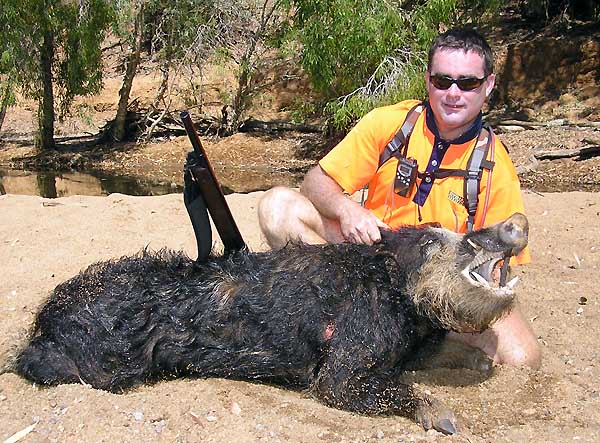 |
| Large boar woken with a load of SG, followed by an RC4 'Evolution' slug behind the shoulder |
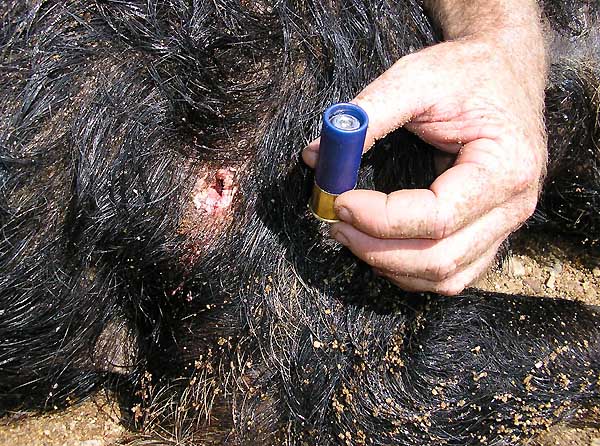 |
| The 12-bore palla makes an impressive entry wound, but sadly that's where it stops! |
 |
| RC4 slug broke up completely within 4 inches, didn't even contact bone! |
At this point I was so bitterly disappointed with the RC4 'Evolution' shotgun slug that I could no longer justify firing them at game during what was, after all, a highly ethical culling operation. To say that I felt cheated would be the understatement of the year, since quite a bit of effort had been invested in resurrecting the Griffiths double gun and regulating it specifically for the RC4 slug. Personal disappointment aside, the more serious potential consequence of the RC4's appalling performance was the high likelihood of a hunter being ripped by a wounded boar. Had I continued to use the 'Evolution' slug, either myself or my hunting partner would have been put at risk of injury sooner or later, possibly jeopardising the whole operation.
Despite witnessing several of my experiences, my hunting partner decided to give the RC4 one final chance if he could find a couple of medium-sized pigs with no risk of a boar in the imediate vicinity. A few days later the opportunity arose and he was able to despatch two ginger sows weighing perhaps 35 and 30 kg respectively in quick succession alongside a drying waterhole. Both were flattened at about 20 yds with a single slug each from his IAC '87 lever-action shotgun. The post-mortems revealed that the first shot penetrated completely through the ribs of the larger sow and exited: a pass-through at last! The second animal was also struck in the rib-cage and although the projectile passed through the lungs it lodged against the far ribs and failed to exit the chest cavity. In the latter case, the slug was largely in one piece although completely torn apart and bearing no resemblance whatsoever to the unfired original!
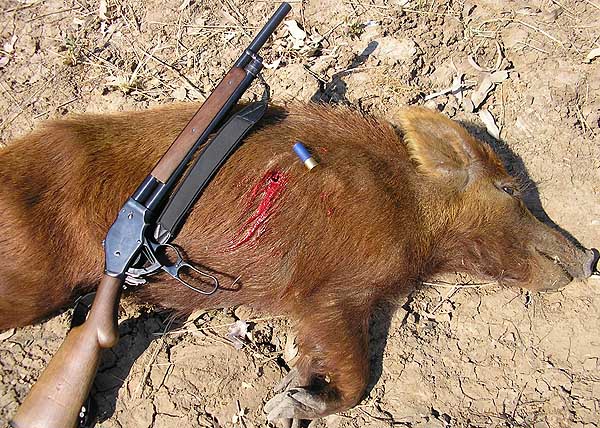 |
| This 35kg sow was the only quarry completely penetrated by the RC4 slug during the trial |
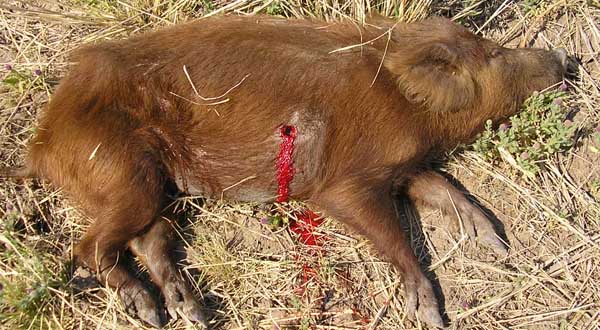 |
| In this instance the slug was stopped dead by the far ribs of a sow weighing a mere 30 kilos! |
 |
| Only 8 inches of penetration on the smaller sow almost destroyed this RC4 slug |
Our conclusion from this 'acid test' was that the RC4 'Evolution' slug is totally unreliable for use on wild pigs in northern Australia, at least if there is any chance of encountering a full-grown boar. ...and isn't that the ultimate goal of any pig hunter after all?! While these cartridges have a definite niche at the firing range, where their outstanding accuracy could be expected to win plenty of medals in Single Action or Practical Shotgun events, they have no place in the field on large or dangerous game. If these cartridges are being imported into the US for use on Texas hogs, I would expect to see some very disappointed hunters state-side as well. Any subsequent litigation could be very interesting!
 |
| Gold graphic of a wild boar's head on the box-label and plastic hull is grossly misleading. |
Heaven help the hapless hunter who equates the RC4 'Evolution' slug with a Brenneke and fires one at a buffalo or scrub bull! Having personally witnessed the effect of hide, muscle and bone on these frangible projectiles I shudder at the very thought! While these cartridges remain available over-the-counter without a warning label, sooner or later someone will be stomped or gored. Hopefully, dissemination of the results of this field trial might go some way towards preventing such a tragedy.